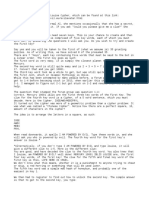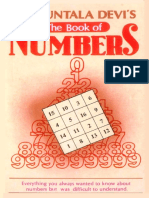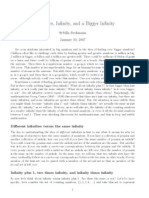Number Devil Project
Number Devil Project
Uploaded by
api-249250107Copyright:
Available Formats
Number Devil Project
Number Devil Project
Uploaded by
api-249250107Original Title
Copyright
Available Formats
Share this document
Did you find this document useful?
Is this content inappropriate?
Copyright:
Available Formats
Number Devil Project
Number Devil Project
Uploaded by
api-249250107Copyright:
Available Formats
Zachary Barringer
Chapter 1: Summary: A boy named Robert is plagued with recurring nightmares. One night he is freed from the nightmares and confronted by a man who identifies himself as the Number Devil. The Number Devil goes on to explain how mathematics is more than arithmetic. He explains how ones can be used to make any number and how there is an indefinite number of numbers, which he then explains with gum. He then uses gum to explain infinitely small numbers. After explaining why numbers were important, he showed that any number could be made of ones. He demonstrated how multiplying any number of ones by itself would create a palindrome that would have all numbers in it up to the number of ones used. However, Robert demonstrated that the trick only worked with up to nine ones, infuriating the Number Devil when he revealed that he had only guessed the number of ones that did not work and accusing the Number Devil of guessing that there was an infinite number of numbers. Mathematical Concepts: Infinitely large numbers-any number can have more added to it, making it larger and the process can be repeated any number of times, each time making a number larger Infinitely small numbers-Take any infinitely large number and put it under a fraction bar with one above it and it becomes equally small
Zachary Barringer
Chapter 2: Summary: Robert once again leaves one of his nightmares to find himself confronted by the Number Devil, this time in forest of one-like trees. The Number Devil begins the night by discussing Roman numerals, and their lack of zero. By highlighting the inefficiency of Roman numerals due to their lack of zero, the Number Devil shows the importance of zero in modern mathematics. When asked by Robert how a zero could do so much he explains it with hopping tens. Hopping is multiplying a number by itself a given number of times, and any number can hop. He concludes by explaining that outing a number farther to the left causes it to be multiplied by a ten that had hopped one more time. Mathematical Concepts: Decimal System: An ancient counting system based on powers of ten. Still used today. Hopping: This is the books name for what is generally known as raising to a power. It means multiplying a number by itself a certain number of times.
Chapter 3: Summary: This night Robert finds himself in a cave with the Number Devil. The Number Devil declares that division is the topic of the day and set Robert some basic problems
Zachary Barringer
which he completes easily. The Number Devil tells Robert that it is more important when a number does not divide evenly than when it does. He says that numbers that do not divide by any number evenly are called prima donnas. He says that they are difficult to work with since it is difficult to determine what numbers are prima donnas, and impossible to do at a glance. He then shows Robert two tricks with prima donnas. First, if you double any number greater than one, then it is guaranteed there is a prima donna between the two numbers. Second, every even number greater than two can be made by adding two prima donnas. Mathematical Concepts: Prima Donnas: Prima donnas are the term used in this book to represent what are commonly known as prime numbers. They are numbers that cannot be divided evenly by any number but one and themselves.
Chapter 4: Summary: The Number Devil introduces Robert to numbers that do not end, such as the decimal equivalent of one-third. He then gets Robert to prove that there is an infinite number of numbers between one and zero, much to the Number Devils satisfaction. The Number Devil then reveals that several numbers can repeat after the decimal, creating even more possibilities. To show what an unreasonable number is, the Number Devil introduces the rutabaga. The rutabaga is hopping backwards once, or finding what
Zachary Barringer
times itself will equal the number of which the rutabaga was taken. He shows that rutabaga two is unreasonable and conclude with a proof that the diagonal of a square with sides 1 unit is the rutabaga of two. Mathematical Concepts: Unreasonable Numbers: This is the Number Devils name for irrational numbers, or numbers that cannot be written as a fraction. Rutabaga: This is the Number Devils term for the square root of a number, or the number that when squared gives the original number. Repeating Decimals: Decimals that do not end, but repeat a single sequence or number.
Chapter 5: Summary: After that, Robert does not see the Number Devil for some time, but when he does, they are in an oasis in the desert. The Number Devil has Robert throw coconuts into a pattern in the sand, revealing the triangle numbers. He shows several tricks with the triangle numbers. First, he shows how any number can be represented as the sum of either two or three triangle numbers. Second, he demonstrates that the sum of any two consecutive triangle numbers is a number hopped twice, or squared. Finally, he shows how to find the sum of any series by adding the first number to the last number,
Zachary Barringer
thee second to last number to the second number, and so on, and multiplying the number of sums by the sum. Mathematical Concepts: Triangle Numbers: This is the Number Devils name for triangular numbers, which are found by adding the number of the term to the previous term; so the fifth term would equal the fourth term plus 5. Sum of Numbers: This is technique for adding a string of numbers with a constant difference together. It is the same as the formula discussed in FST for finding the sum of arithmetic sequences, and was originally discovered by Carl Gauss.
Chapter 6: Summary: Robert falls asleep to find himself in a potato field with the Number Devil. At first they talk, and the Number Devil reveals the existence of Number Heaven, the home of all Number Devils. After this, the Number Devil spoke of his good friend Bonacci, and a string of numbers that he had discovered, found by adding the previous two terms of the sequence. He then made the claim that nature acted as if it knew the sequences that mathematicians had discovered. To prove his point and, overcome Roberts disbelief, he produces two rabbits and accelerated their growing and breeding cycles.
Zachary Barringer
To Roberts amazement, the number of rabbits correlated perfectly with the Bonacci sequence.
Mathematical Concepts: Bonacci Sequence: The Number Devils name for the Fibonacci sequence, a sequence found by starting with one and adding the previous two terms to find th next term.
Chapter 7: Summary: When next Robert finds himself in the Company of the Number Devil, they are in a plain white house with no furnishings. The Number Devil helps Robert build a triangle out of electronic blocks. After the triangle is built, the Number Devil start labeling it by putting a one at the top. He then tells Robert that the value of any square is equal to the sum of the two squares directly above it. He shows Robert some of the patterns in this number triangle including the varying triangles caused by both prima donnas and multiples of five. Mathematical Concepts: The Number Triangle: Known commonly as Pascals Triangle, this triangle is famous for its many patterns, both geometric ones, formed by shading certain
Zachary Barringer
types of numbers, to number based ones such as the integers listed down the sides is the second most outside column.
Chapter 8: Summary: Robert dreams of his classroom, much to his dismay. However, instead of his teacher, he sees the number devil walk in to teach the class. The Number Devil has Robert write down various seating arrangements of his classmates, introducing Robert to the sheer number of possibilities of arrangements. Once he dismisses the rest of the class, the Number Devil tells Robert about how he can use the vroom! of a number to see how many possible combinations there are in a seating arrangement. He then shows how handshakes can be found with triangle numbers since the handshakes do not need to repeat. He then shows how the rows of Pascals triangle can be used to find how many ways a group can sweep with a limited number of brooms. Mathematical Concepts: Vroom! : This is the Number Devils name for a factorial, or the product of all numbers from the number through one. This is used in FST to find the permutation when all the options are picked. Handshakes: The triangular numbers can be used to find the number of handshakes because they add a hand shake for every person already there when another person is added.
Zachary Barringer
Pascals Triangle: This represents another pattern in Pascals Triangle; in the combination of n choose r, the row represents n, and the distance from the left is the r.
Chapter 9: Summary: When Robert is sick in bed, the Number Devil pays him a sick call. He brings along a group of people in t-shirts that represent various types of numbers. These he uses to show Robert that since there is an infinite number of numbers, there is an equal number of all types of numbers, since they all pair up, even is some increase faster than others. He then introduces Robert to series, sequences of numbers that are added together. He shows Robert one series that adds to one if followed to infinity. Next he shows Robert one that appears to do the same but then shows him how it does not. Mathematical Concepts: Series: A sequence of numbers that are added together Converging Series: Series that when added for an infinite amount of time will equal a value, or will approach that value if not followed to infinite. Diverging Series: Series that approach infinity the longer they are added.
Chapter 10: Summary:
Zachary Barringer
Robert discovers that he is in a movie theater, watching a very detailed video of a blizzard with very large detailed flakes. He uses the Fibonacci sequence to introduce Robert to a number by dividing each number by the one preceding it. He then shows how that number is also the ratio of the side of a pentagon to a line of a star inscribed in said pentagon. Next, he shows how the dots plus the spaces minus the lines of any two-dimensional figure is equal to one. He then reveals how the same works for three-dimensional figures, except the answer is two instead of one. Mathematical Concepts: Dots, Spaces, Lines : The dots are vertices of the figure, the spaces are faces on three dimensional figures and the lines are called edges
Chapter 11: Summary: When Robert next dreams, he is being chased through dark streets by dozens of copies of his teacher before he is rescued by the Number Devil. They begin an in depth conversation on mathematical proofs. Robert is dissatisfied with the reasons the Number Devil is giving him for many of the things he has been shown. The Number Devil approves of this attitude and explains that this is the reason why mathematicians continue to discover new things. He uses the analogy of a river crossing to explain how mathematicians start with known facts, and use deductions based on those facts to determine a new theorem to explain part of mathematics, similar to reaching the other
Zachary Barringer
side of the bank. He then tells several anecdotes about precision and both the importance and difficulty of proofs. Mathematical Concepts: [None] Chapter 12: Summary: The Number Devil brings an invitation to Robert the next time he dreams. It invites him to Number Heaven for a banquet. Once there, he meets several mathematicians, from his Number Devils friend Bonacci to Carl Friedrich Gauss. He eats at the banquet then meets the General Secretary of Number Heaven who anoints him into the Order of Pythagoras, Fifth Class. The next day he was struck by mathematical inspiration during a math problem and easily solves a problem that had occupied everyone else for several minutes. Mathematical Concepts: [none]
You might also like
- Opening Ceremony ProgrammeDocument4 pagesOpening Ceremony ProgrammeDracoVolans100% (10)
- Science of NumbersDocument66 pagesScience of NumbersAnonymous SoUejG9100% (5)
- Theories Into PracticeDocument16 pagesTheories Into PracticeKrittiya PermpanichNo ratings yet
- Numero - The Power of NumbersDocument83 pagesNumero - The Power of NumbersMike Songer100% (2)
- Number DevilDocument2 pagesNumber Devilapi-227053548100% (1)
- Employment Application Form: Accenture Solutions Private LimitedDocument8 pagesEmployment Application Form: Accenture Solutions Private LimiteddivyaNo ratings yet
- Thepeasantprince Yr3unitDocument6 pagesThepeasantprince Yr3unitapi-222745762100% (1)
- Introduction and Summary of The Rodin Coil and Vortex Based MathmaticsDocument7 pagesIntroduction and Summary of The Rodin Coil and Vortex Based Mathmaticsmarkorodin100% (1)
- The Thirteenth Night (Number Devil Short Story)Document9 pagesThe Thirteenth Night (Number Devil Short Story)api-280094271No ratings yet
- Rodin PaperDocument31 pagesRodin PaperKeith W Barnwell100% (3)
- MayaGlyphsBook2 PDFDocument118 pagesMayaGlyphsBook2 PDFOlusanya BeyNo ratings yet
- Answer Case Study-Smart CityDocument2 pagesAnswer Case Study-Smart CityRizky Almadinah AgustyNo ratings yet
- Bar Model JuniorDocument59 pagesBar Model JuniorptbestariNo ratings yet
- t2 e 5356 Simple Past Present and Future Tense Powerpoint - Ver - 4Document18 pagest2 e 5356 Simple Past Present and Future Tense Powerpoint - Ver - 4Dr.Eman MostafaNo ratings yet
- Mandarin Excellence Programme: Teaching ResourcesDocument14 pagesMandarin Excellence Programme: Teaching Resourcesdemille2 TNo ratings yet
- Animal Adaptations Activity BookDocument8 pagesAnimal Adaptations Activity Bookapi-450175685No ratings yet
- Banarch TarksiDocument6 pagesBanarch TarksiShehroz KhanNo ratings yet
- COLLEGE ALGEBRA December 2023 Part 1Document85 pagesCOLLEGE ALGEBRA December 2023 Part 1Peter PettoNo ratings yet
- The Real Number SystemDocument32 pagesThe Real Number SystemviksoniNo ratings yet
- Understanding AlgebraDocument133 pagesUnderstanding AlgebraApril ShowersNo ratings yet
- Goodmath PreviewDocument5 pagesGoodmath PreviewScribNo ratings yet
- Lecture1 ADocument8 pagesLecture1 AHaseeb UllahNo ratings yet
- Algebra I Lesson 1.5 - Square Roots and Real Numbers Mrs. Snow, InstructorDocument2 pagesAlgebra I Lesson 1.5 - Square Roots and Real Numbers Mrs. Snow, InstructorVictoria StewartNo ratings yet
- Square Roots: ApproximatelyDocument21 pagesSquare Roots: ApproximatelyApril Diane Mamucod AvigueteroNo ratings yet
- A Brief Introduction To InfinityDocument7 pagesA Brief Introduction To InfinityRamses IviivNo ratings yet
- The Number Devil Chapter TwoDocument1 pageThe Number Devil Chapter TwoLeidi virgovanigilNo ratings yet
- Completed Real NumbersDocument19 pagesCompleted Real NumbersIsrar AliNo ratings yet
- Lectures For Your HelpDocument25 pagesLectures For Your HelpRahul MishraNo ratings yet
- The Real Number SystemDocument36 pagesThe Real Number SystemKalson UmpuNo ratings yet
- Background of Pascal's TriangleDocument4 pagesBackground of Pascal's TriangleFrancisNo ratings yet
- Fantastic Numbers and Where to Find Them: A Cosmic Quest from Zero to InfinityFrom EverandFantastic Numbers and Where to Find Them: A Cosmic Quest from Zero to InfinityNo ratings yet
- Mitocw - Watch?V Eg8Djywdmyg: ProfessorDocument13 pagesMitocw - Watch?V Eg8Djywdmyg: ProfessorDevendraReddyPoreddyNo ratings yet
- Jinx 022Document13 pagesJinx 022Maarten BosmansNo ratings yet
- Fundamental Theorem of AlgebraDocument11 pagesFundamental Theorem of Algebraja_mufc_scribdNo ratings yet
- 2.2 Decimals and Real Numbers: Home Calculus For Beginners Tools Glossary Index Up Previous NextDocument2 pages2.2 Decimals and Real Numbers: Home Calculus For Beginners Tools Glossary Index Up Previous NextZerihun IbrahimNo ratings yet
- Loucypher Secret KeysDocument4 pagesLoucypher Secret KeysRoberto QuirozNo ratings yet
- The Book of NumbersDocument148 pagesThe Book of NumbersYamunapriyan 123No ratings yet
- Computational Thinking 720p enDocument34 pagesComputational Thinking 720p enMartin PascualeNo ratings yet
- The Book of NumbersDocument146 pagesThe Book of NumbersAnu Rajendran100% (6)
- Fibonnaci Gauge208Document21 pagesFibonnaci Gauge208Dinindu Siriwardene100% (2)
- Million Random DigitsDocument221 pagesMillion Random DigitskrazzygeniusNo ratings yet
- Problem Solving CompilationDocument4 pagesProblem Solving Compilationnos rejNo ratings yet
- 2.2 Decimals and Real NumbersDocument1 page2.2 Decimals and Real NumbersRakesh S IndiaNo ratings yet
- Patterns and Inductive ReasoningDocument22 pagesPatterns and Inductive ReasoningYoAmoNYCNo ratings yet
- Big Bigger 2Document5 pagesBig Bigger 2jhicks_mathNo ratings yet
- GE MMW MODULE 1 - Lesson 2Document4 pagesGE MMW MODULE 1 - Lesson 2Meah LabadanNo ratings yet
- Scott Onstott - Taking Measure - Explorations in Number, Architecture and Consciousness PDFDocument130 pagesScott Onstott - Taking Measure - Explorations in Number, Architecture and Consciousness PDFpep100% (1)
- Additional Readings About Fibonacci Sequence in NatureDocument6 pagesAdditional Readings About Fibonacci Sequence in NatureTrisha Bendaña ReyesNo ratings yet
- Continuity, Completeness, and Connectedness of A Real LineDocument9 pagesContinuity, Completeness, and Connectedness of A Real LineShivangi ChandelNo ratings yet
- Sistem Bilangan (Eng. Numeral System) : Dedy Wirawan SoedibyoDocument28 pagesSistem Bilangan (Eng. Numeral System) : Dedy Wirawan SoedibyoSebastian RussarkNo ratings yet
- HowStuffWorks - How Zero WorksDocument3 pagesHowStuffWorks - How Zero Workssandra072353No ratings yet
- 19Document16 pages19VivekRouthNo ratings yet
- The Grapes of Math: How Life Reflects Numbers and Numbers Reflect LifeFrom EverandThe Grapes of Math: How Life Reflects Numbers and Numbers Reflect LifeRating: 3.5 out of 5 stars3.5/5 (2)
- Video 10 Expressions Part-2Document6 pagesVideo 10 Expressions Part-2Riaz KhanNo ratings yet
- A Brief Taxonomy of NumbersDocument23 pagesA Brief Taxonomy of NumbersJosef BreuerNo ratings yet
- Shell Mex House Pearsons PLC History British Intelligence and OilDocument8 pagesShell Mex House Pearsons PLC History British Intelligence and OilJohn Adam St Gang: Crown ControlNo ratings yet
- Shard of Spring - Manual - C64 PDFDocument14 pagesShard of Spring - Manual - C64 PDFMark BallingerNo ratings yet
- N101 7 Introduction To Quantified NutritionDocument14 pagesN101 7 Introduction To Quantified Nutritionsheela deviNo ratings yet
- SuccessionDocument20 pagesSuccessionCalif P. AmindatoNo ratings yet
- ManageEngine DDI Central User Guide (1) - 1-232Document232 pagesManageEngine DDI Central User Guide (1) - 1-232akshra7gjNo ratings yet
- Msds-Canroyal Diesel Engine Oil Sae 15W40 Api CH4 SLDocument8 pagesMsds-Canroyal Diesel Engine Oil Sae 15W40 Api CH4 SLcatpilar274No ratings yet
- Kinds of Companies and Its FeaturesDocument15 pagesKinds of Companies and Its FeaturesNidharshanaa V RNo ratings yet
- CHAPTER 18 PIPING SYSTEMS - Marine-Engineering-Roy-l-Harrington-1971 PDFDocument19 pagesCHAPTER 18 PIPING SYSTEMS - Marine-Engineering-Roy-l-Harrington-1971 PDFNur SalimNo ratings yet
- Aldwin Jann Louis Y. AlmazanDocument3 pagesAldwin Jann Louis Y. AlmazanSalman DelfinNo ratings yet
- Biomimicry in Architecture (2nd Ed.) 17508975.2017.1309949Document2 pagesBiomimicry in Architecture (2nd Ed.) 17508975.2017.1309949jeremy.costaNo ratings yet
- Alcatel-Lucent 4059 IP Attendant Console User ManualDocument69 pagesAlcatel-Lucent 4059 IP Attendant Console User ManualMisses QuotesNo ratings yet
- 1.introduction (Chimtali)Document28 pages1.introduction (Chimtali)lytonchirwa882No ratings yet
- Research in Clinical Pragmatics: Louise Cummings EditorDocument657 pagesResearch in Clinical Pragmatics: Louise Cummings EditorFel CruzNo ratings yet
- EGMC001 Principles of Economics BothDocument1,250 pagesEGMC001 Principles of Economics Bothanish13121991No ratings yet
- Brigada Eskwela and Brigada Pabasa: S.Y. 2021 - 2022 DAY 1: SEPTEMBER 06, 2021Document5 pagesBrigada Eskwela and Brigada Pabasa: S.Y. 2021 - 2022 DAY 1: SEPTEMBER 06, 2021noel bandaNo ratings yet
- AMERICAN MONSTERS by Chris GrillotDocument109 pagesAMERICAN MONSTERS by Chris Grillotnoldorian23No ratings yet
- Entrep Mind Module 2Document7 pagesEntrep Mind Module 2Wynnie RondonNo ratings yet
- Guide To Nutrilite Liv 360 Order ProcessingDocument21 pagesGuide To Nutrilite Liv 360 Order ProcessingRaghu NayakNo ratings yet
- Checklist A1 Version 1.0Document11 pagesChecklist A1 Version 1.0Renzo Diaz DelgadoNo ratings yet
- 1203 Weight Transmitter Reference Manual: For Use With Software Versions 1.0 and AboveDocument56 pages1203 Weight Transmitter Reference Manual: For Use With Software Versions 1.0 and Abovesongs SomervilleNo ratings yet
- Pittsfield Schools FY16 Budget BookDocument117 pagesPittsfield Schools FY16 Budget BookiBerkshires.comNo ratings yet
- Vengeance Is Self-FocusedDocument18 pagesVengeance Is Self-FocusedCarolina LenisNo ratings yet
- The Clockmaker's DaughterDocument2 pagesThe Clockmaker's DaughternicksmcdonaldNo ratings yet
- Conversation IxDocument10 pagesConversation IxWau BijakNo ratings yet
- Topic Identification of Instagram Hashtag Sets For Image Tagging: An Empirical AssessmentDocument12 pagesTopic Identification of Instagram Hashtag Sets For Image Tagging: An Empirical Assessmentrf001No ratings yet
- Mrinmaydeycommunication Ce (Oe) 601a 10601321042Document6 pagesMrinmaydeycommunication Ce (Oe) 601a 10601321042mchayan489No ratings yet
- ĐỀ KIỂM TRA CUỐI KÌ II Anh 10 form mới- Nam Tiền HảiDocument5 pagesĐỀ KIỂM TRA CUỐI KÌ II Anh 10 form mới- Nam Tiền Hảidocumentclassa7No ratings yet

























































































